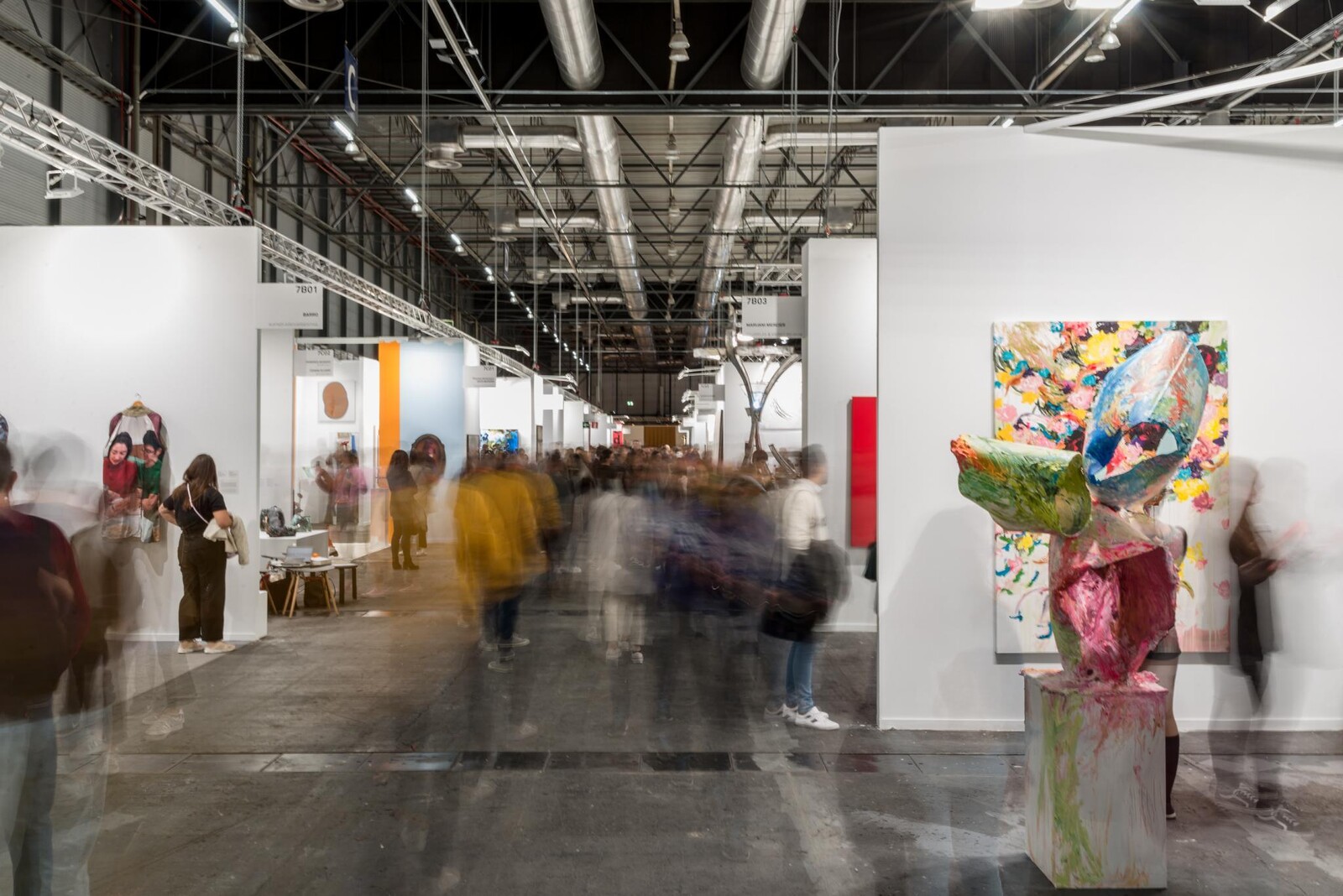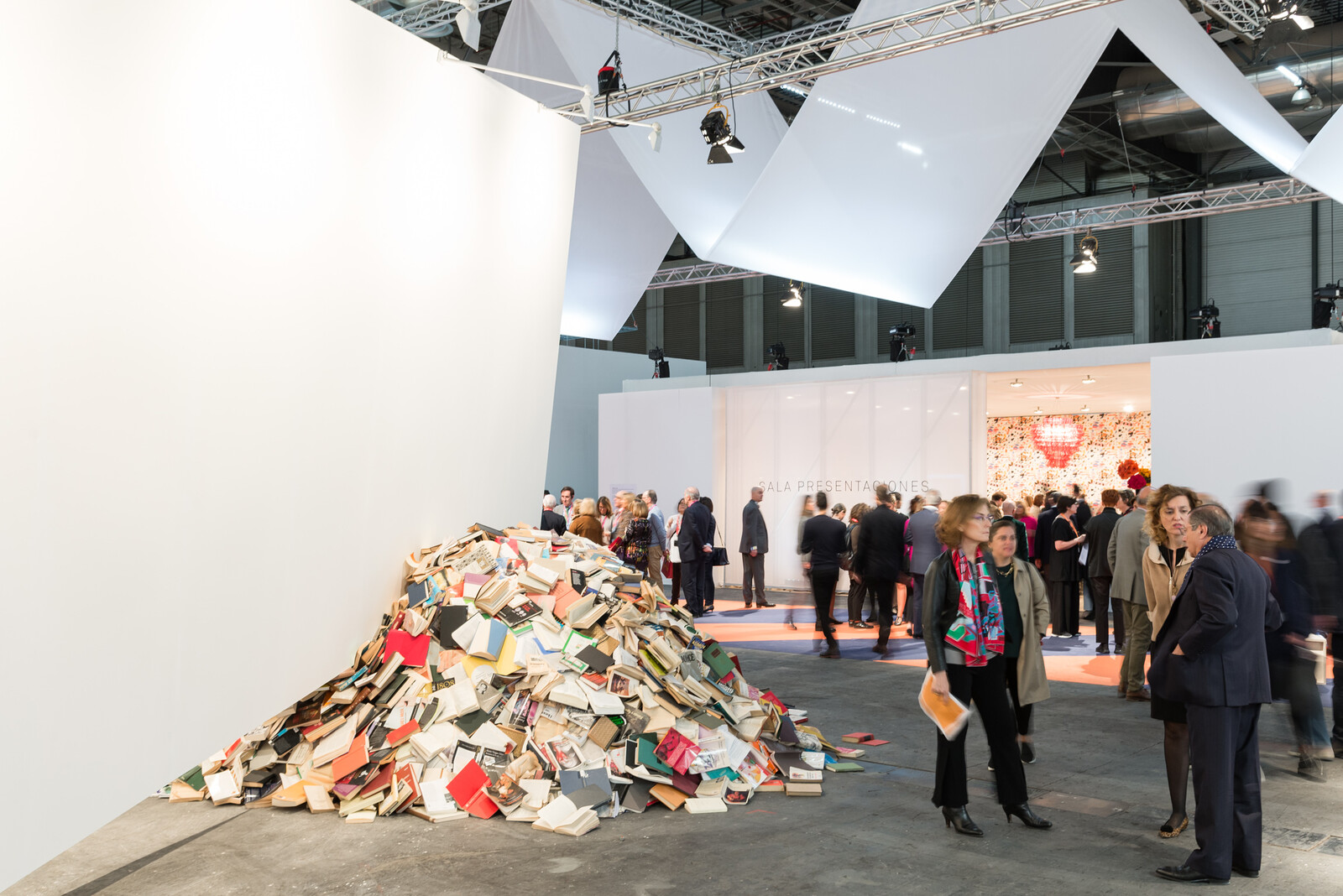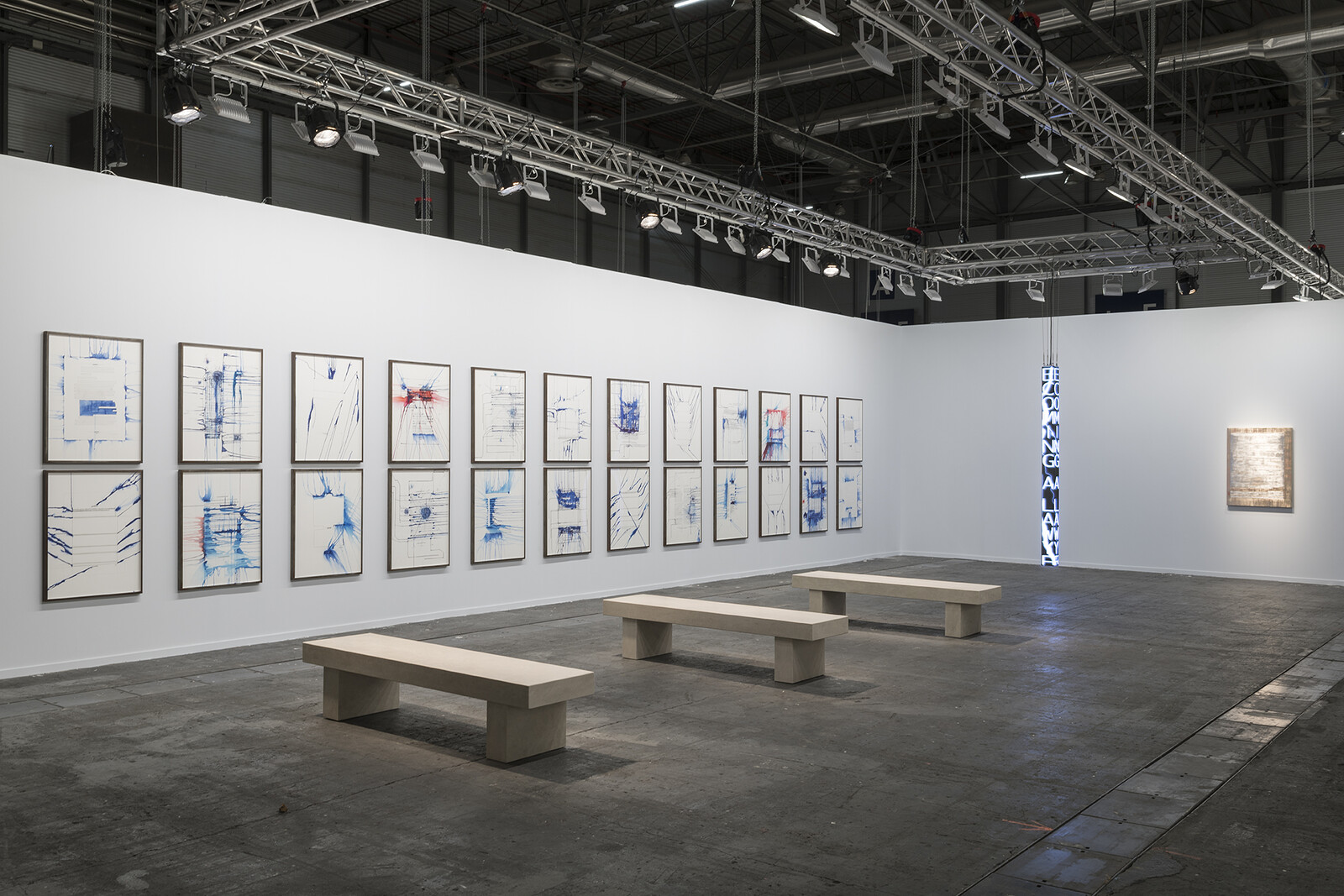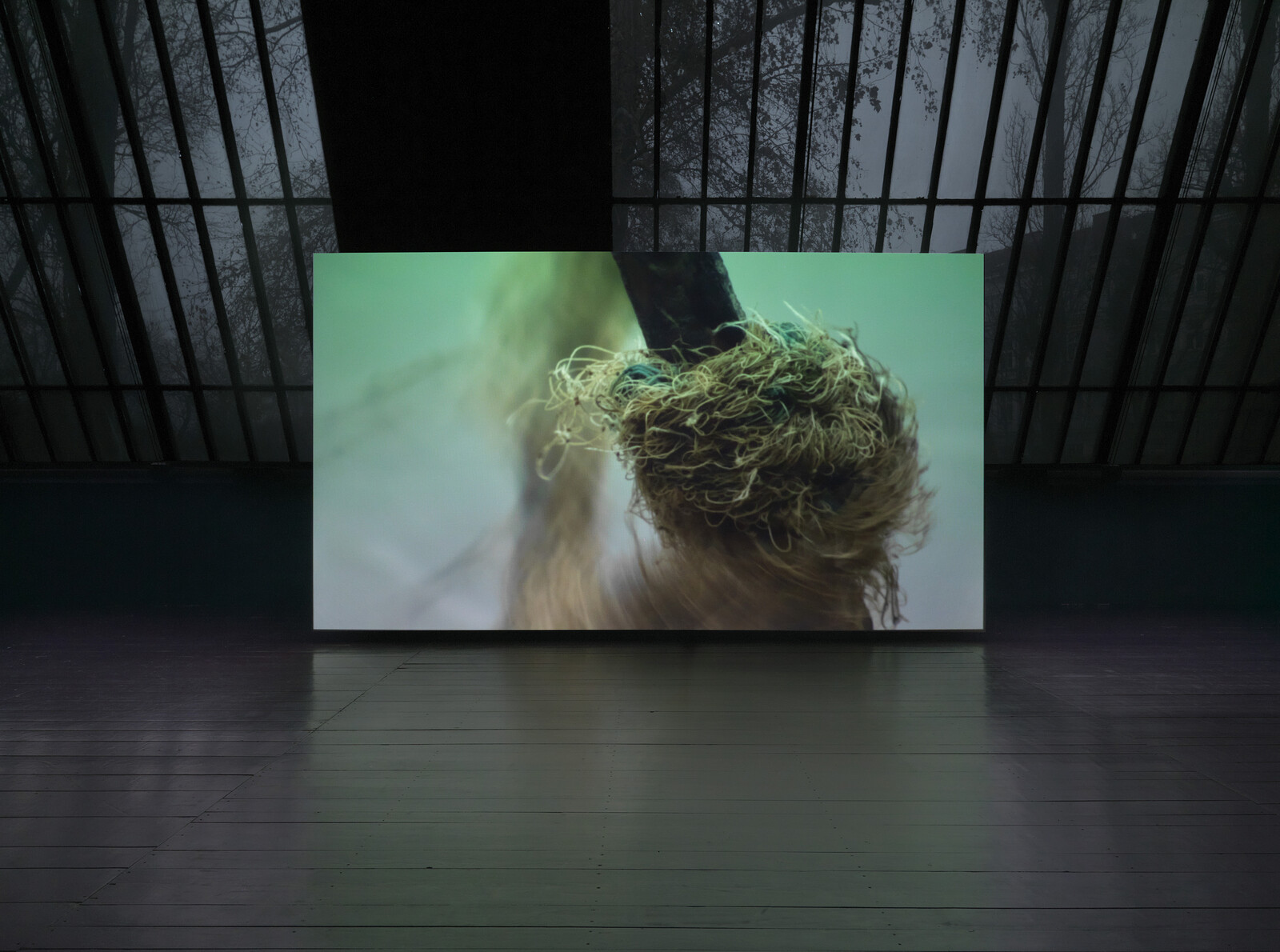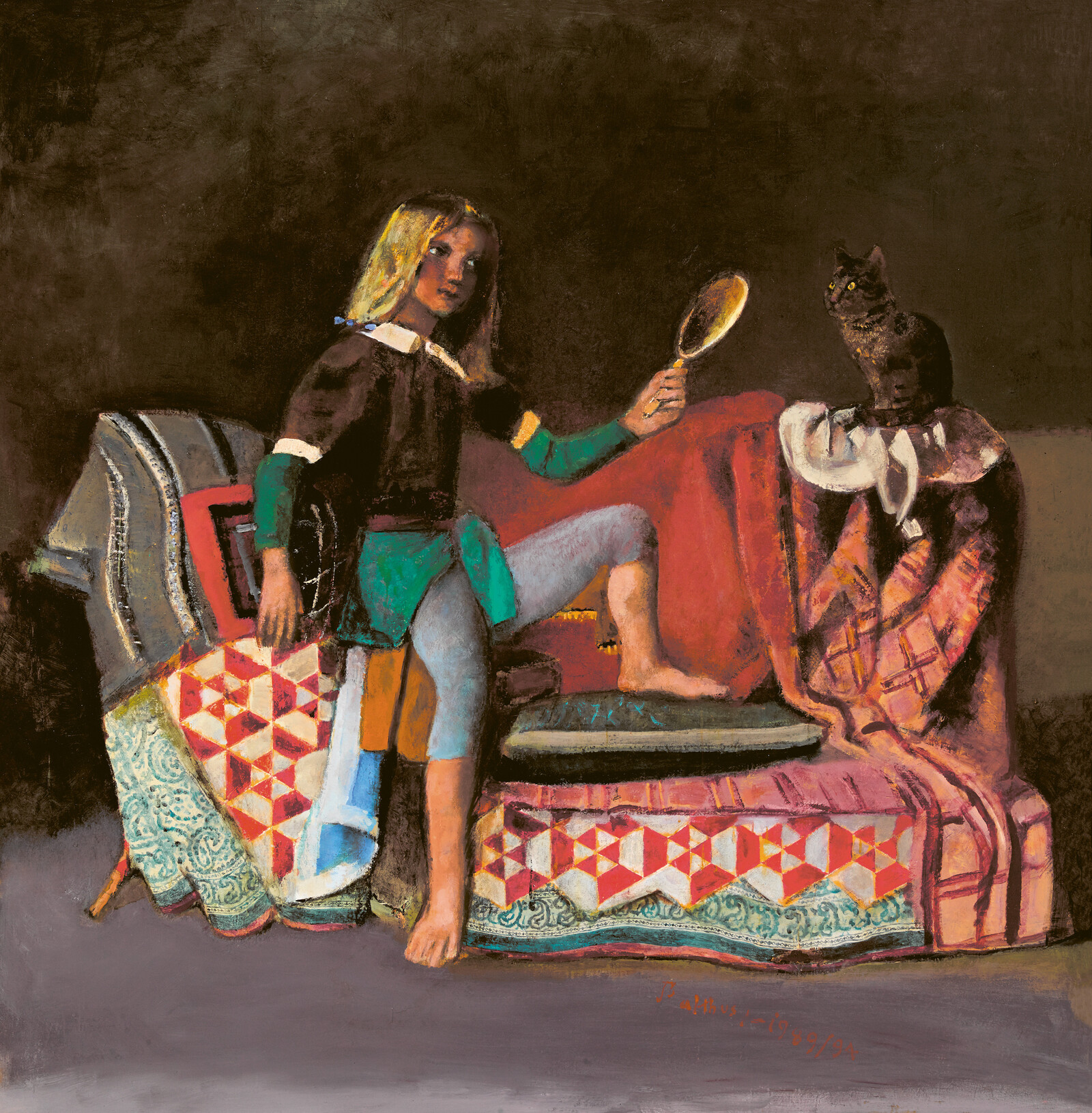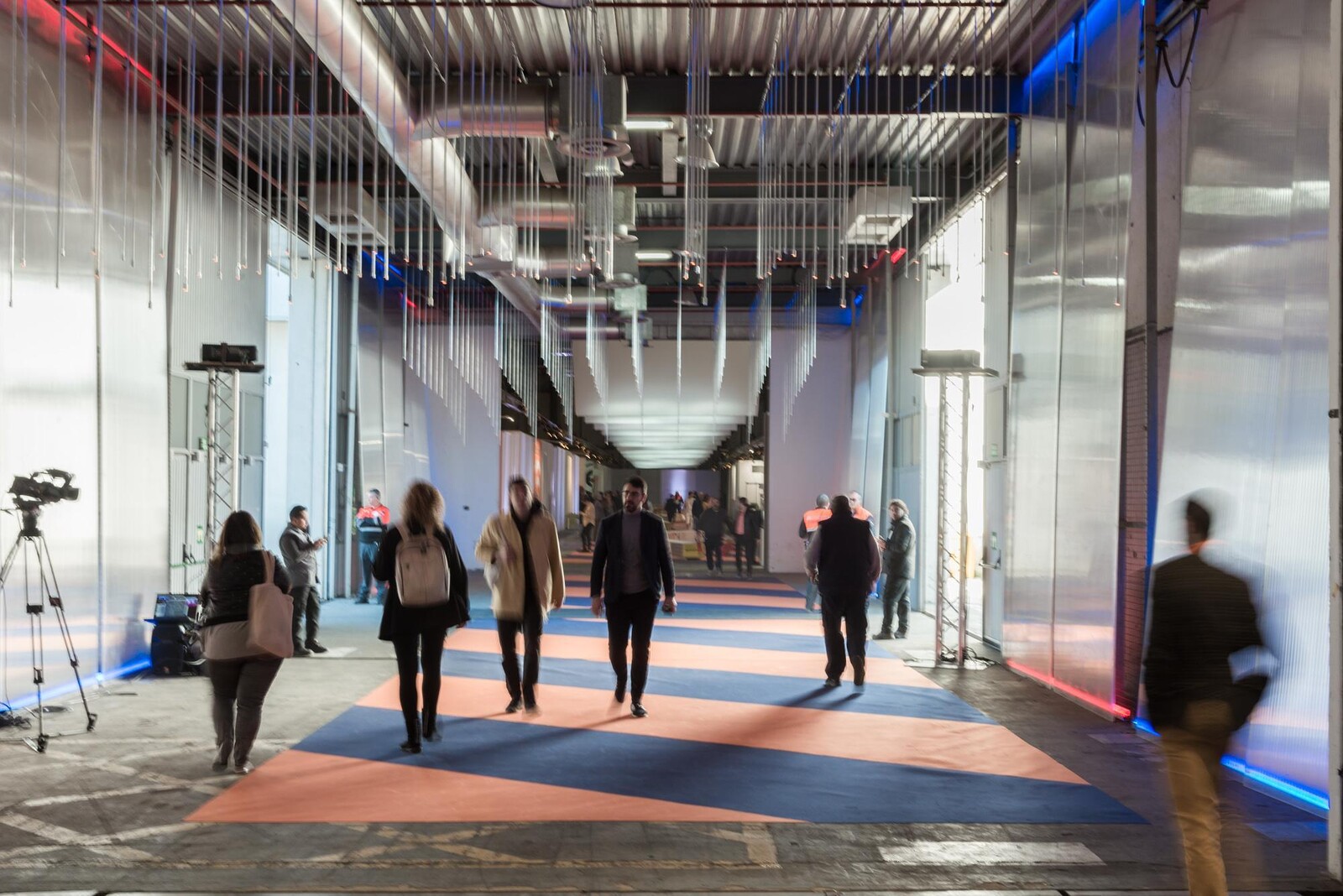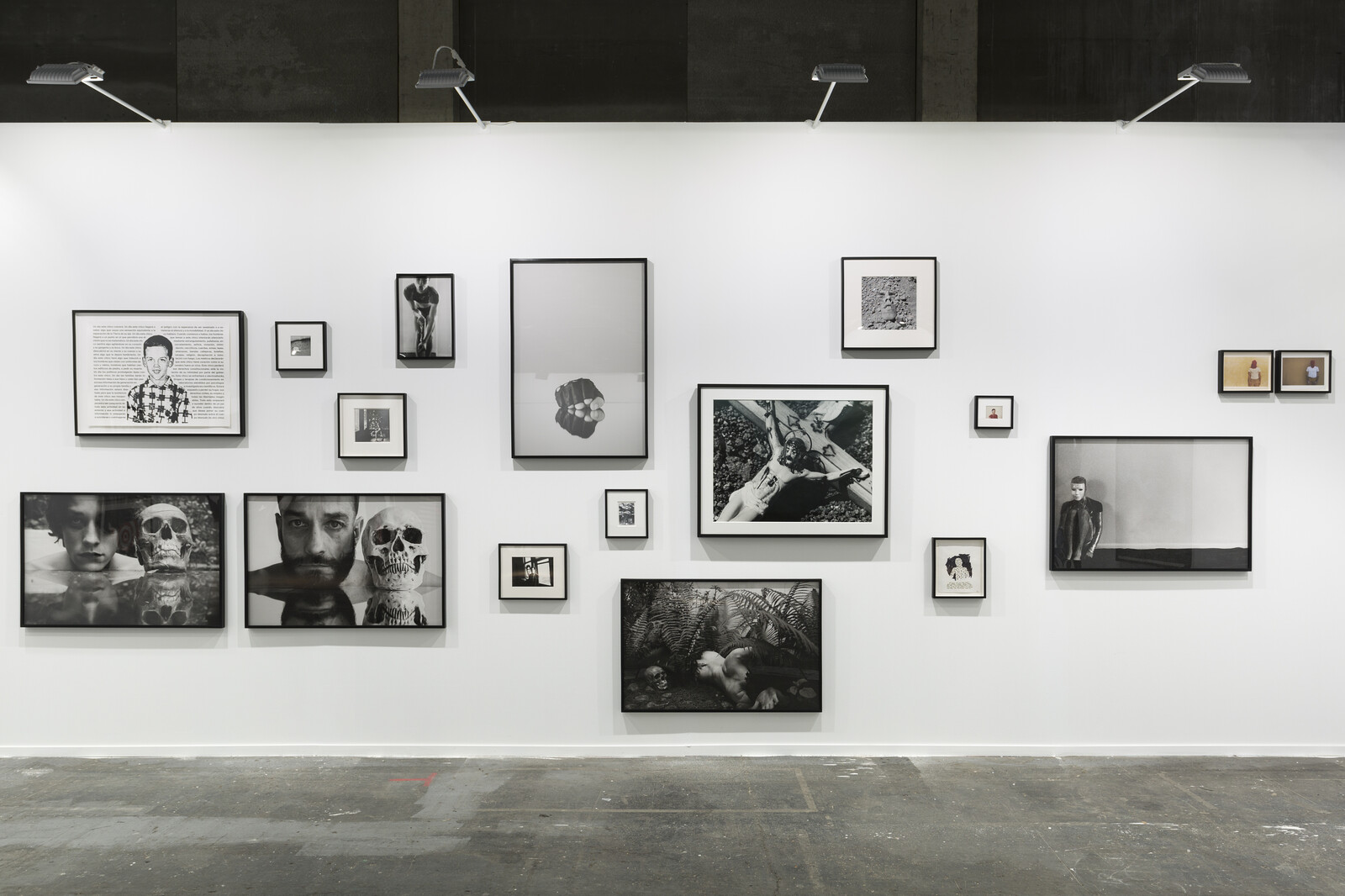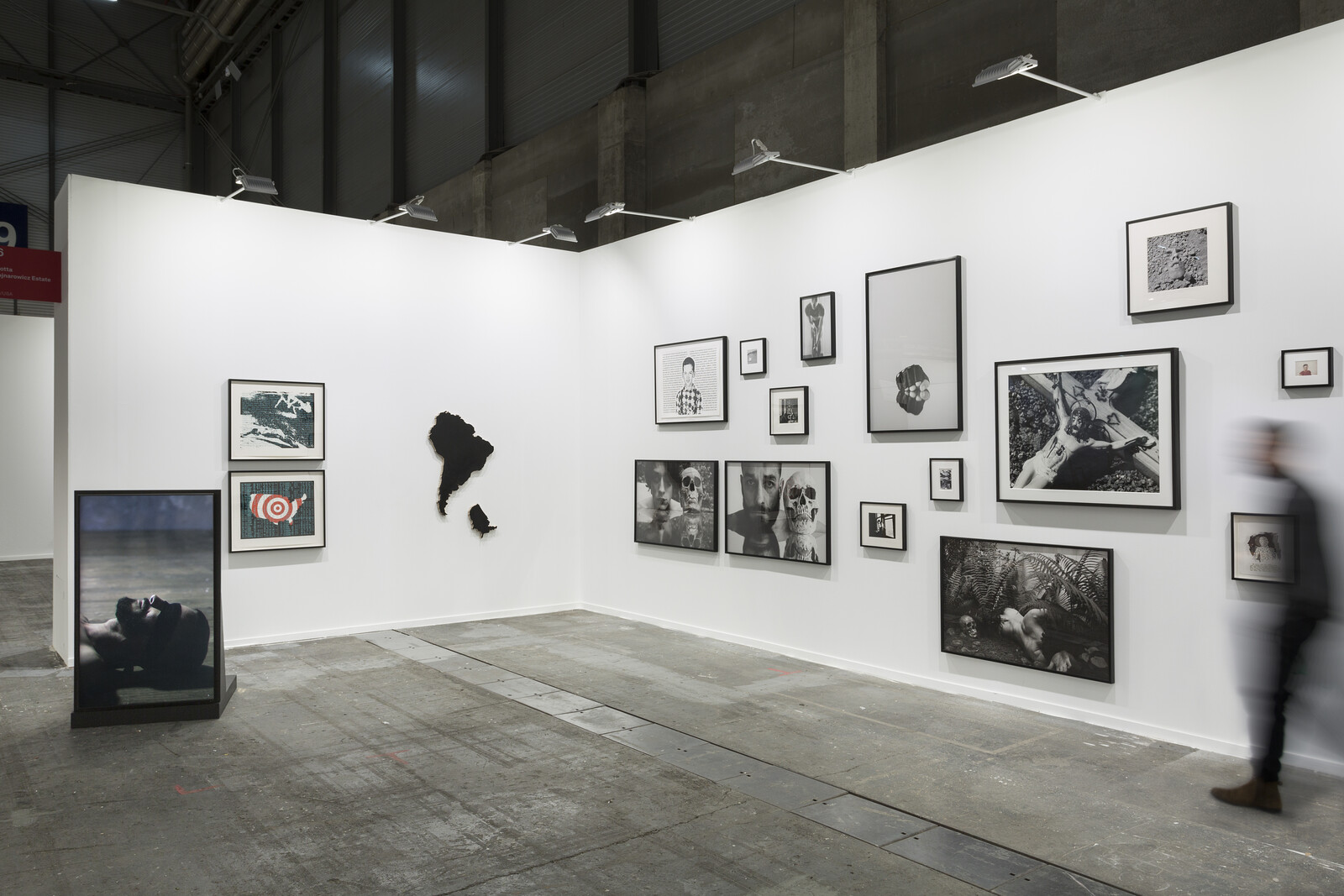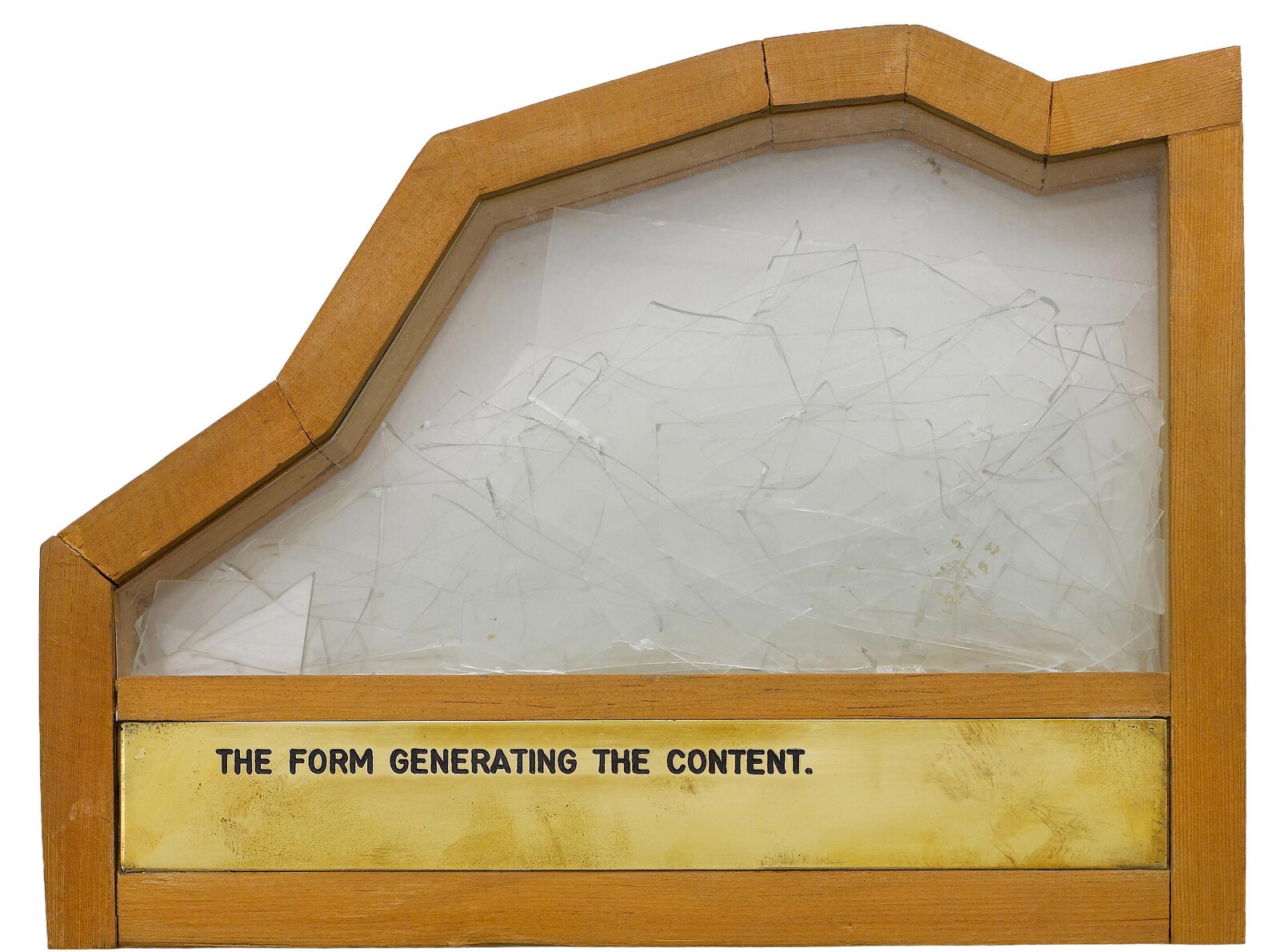“Slightly shattered shards of substance thrown within the grasp of the current of a river / Ligeramente dañados pedazos de sustancia arrojados a la merced de la corriente de un río”: you read Lawrence Weiner’s writing in English and Spanish splattered across a wall as the flow of humans drags you through the endless booths of the art fair. (Was it Galería Horrach Moya from Palma de Mallorca? The tide moved too quickly to catch it.) You’re not sure if you’re the shards or the art is or you both are, but you know that the river is ARCOmadrid 2019. Spain’s biggest art fair has distinctive qualities. The giant convention center simultaneously hosts an air-conditioning convention, a huge concentration of Latin American galleries, planeloads of VIPs flown in for private conferences, along with a scatter of curated sections trying to find distinctive voices amongst the glut all the other fairs. Frieze LA last week, Armory next.
Into the limestone bench of RAPTURE (2017), Jenny Holzer carved “Rapture Screamed Toward the Clouds.” The poetic clarity and political force of Hauser & Wirth’s booth, dedicated to a survey of over 30 years of the artist’s work, set a mood. In MOVE (2015), words drawn from interviews with victims from the war in Syria flickered on LED screens like a newsflash. About an earlier series of benches, Holzer said the words were drawn from “What actually happens to peoples’ lives as a result of unnecessary disasters.”1 The political weather outside is frightening, and artists weather-vane and resist in a million ways.
Many maintain a strange attraction and repulsion to fairs: the intense traffic and overexposure, the exhaustive carnival sprawl of gestures and objects, dreams and ideas (mostly for sale) from all over. At ARCOmadrid, this included 203 galleries from 31 countries, in addition to 15 from Peru, another 13 in the two-person “Dialogues” presentations, and 21 in the “Opening” section for emerging galleries. A conclave of networky energy and old friends, of hopes pinned on commerce, and the weird thrill of shopping (at least for some) suffuses every art fair with its perfume of dread and desire. You march through every booth, at first with jaunty bemusement, measuring and memorizing every step, snapping pics of objects and wall labels to try to grasp something in the blur to hang your memories upon. This is total boilerplate for all art fairs, but writing it down makes you feel better.
The revelation strikes you that these days in Madrid could be read in any number of wildly different combinations: less a coherent cultural experience than a Choose Your Own Adventure. You could have leered your way through Balthus’s retrospective at Museo Thyssen-Bornemisza and the scatter of Alex Katz paintings at the fair, including a double-shot of a young woman in a Calvin Klein sports bra posing for the painting at London gallery Timothy Taylor’s booth (CK 4, 2017). You could see this week of heartbreak, catastrophe, and political crime marked with macabre conceptual grace in Luis Camnitzer’s retrospective “Hospice of Failed Utopias” at Museo Reina Sofia, along with Amar Kanwar’s survey of human struggle against misogyny and ecological catastrophe, again at Thyssen-Bornemisza, just a few steps from the Balthus show. Or you could have nodded seriously through serious curatorial efforts from the stridently au courant “Drowning in a Sea of Data” at La Casa Encendida, about the anxiety of tech accelerationism, or the research-heavy “Winning by Losing” at CentroCentro, which “questions the paradigm” in the opening sentence of its companion essay.
Or you could have just concentrated all your attention on Eugenio Merino and Santiago Sierra’s 14-foot effigy of King Felipe VI of Spain—and its not inconsiderable local controversy—at Milan’s Prometeogallery di Ida Pisani back at ARCOmadrid. The buyer is contractually obliged to burn the effigy, titled NINOT (2019), within a year of purchase, the privilege of which costs 200,000 euros (there’s some kind of skull you get to keep). Asked about Merino and Sierra’s provocation at an informal press conference on the opening day, the fair’s outgoing director Carlos Urroz replied: “There’s over 800 artists here. It does not seem fair that two artists take all the attention.”2 A headline-nabbing provocation or a critique of institutionalized nepotism? It’s hard to tell.
And maybe you don’t choose your own adventure, maybe it chooses you, and within the swirl and crush you manage to string together a few still points in a churning world. Those moments of epiphany in the thrum and thrall jump out unexpectedly. You’re uncertain why they stick, but they do. Tucked into one of the smaller corners of the fair, a little diorama of a karaoke room flickers with colored light, the hum of music, lyrics flashing across the screen, all built by Bernd Oppl at Vienna’s Galerie Krinzinger. I don’t normally thrill to tromp l’oeil constructions, but Oppl’s darkling diorama, in the middle of all the bright noise and harsh light, the preening and prodding and patrolling of the art fair, felt like a blessing. Within this diminutive karaoke club, called Rhythm of the Night (2019), I found a welcome shadow, a tiny space of hope and expression without any stakes at all: performance and expression as a matter of joy, communion, and release, not profit or fame. Nothing wrong with making a living, but the hustle of it wears the spirit down.
Over in the “Dialogues” section, New York’s PPOW placed David Wojnarowicz with Carlos Motta. I felt all the fierce beauty of both, the sexual and political force, the cold fingers of mortality of the epidemic that took David’s life, the catastrophe from which Carlos still feels aftermath (as many of us do). Carlos’s Self-Portrait with Death #1 (1996/2018), which shows the artist young and bold and fragile, chin resting on a gleaming car hood, stares at the camera next to the empty eyes of a skull, and his Self-Portrait with Death (2019), showing the artist older, bearded, next to another skull, whispered something about survival, its difficulty, and the fight we lend to life over time.
A few booths away, at Berlin’s ChertLüdde, I found the irregular, shapely sculptures of Rodrigo Hernandez and the irregular, shapely typographic poetry of Ruth Wolf-Rehfeldt. Fifty years between them, Rodrigo’s delicate, multidimensional pastel cardboard constructions find a quiet friendship with the monochromatic sheets of Ruth’s unspun language and punctuation. Tucked into an corner (maybe I just like corners to hide in at art fairs), a sensuous painting of a curvy polychrome body found itself slithering on wallpaper made by Rodrigo in homage to Ruth, an endless ocean of plus-signs and dashes, a Morse code of symbols referring to nothing but its own beauty.
But the work that haunts me, still and maybe always, is by Camnitzer from 1978 in his retrospective at Reina Sofia. A wooden box with glass front hanging on the wall, a sepia photograph of a vast sky with a few wisps of clouds, and, in the bottom, the words (which also serve as the work’s title) “Victims View Found on the Altar of Sacrifices at Teotihuacan.” I can imagine Luis or myself lying on that ancient altar to look at the sky, the coolness of the stone pressed against a sweaty back. One last memory before a violent death. Did this rapture scream before the clouds? Such a peaceful sky to say goodbye to this world. Another still point in a churning world.
Interview between Jenny Holzer and Diane Waldman, June 6 and July 12, 1989, in Jenny Holzer (New York: Solomon R Guggenheim Museum, 1989), 17.


